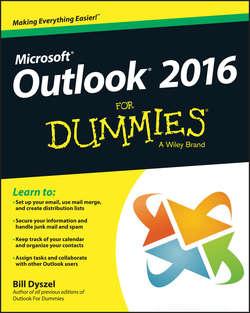Читать книгу Outlook 2016 For Dummies - Dyszel Bill - Страница 12
На сайте Литреса книга снята с продажи.
Part I
Getting Started With Outlook 2016
Chapter 1
Outlook Features You Really Need to Know
Using Email: Basic Delivery Techniques
ОглавлениеEmail is Outlook’s most popular feature. I’ve run across people who didn’t know Outlook could do anything but exchange email messages. It’s a good thing that Outlook makes it so easy to read your email, although it’s too bad so many people stop there.
Reading email
When you start Outlook, you normally see a screen with three columns. The leftmost column is the Folder pane, which lets you switch between different modules in Outlook to perform different tasks. The second column from the left is your list of messages; the right column (called the Reading pane) contains the text of one of those messages. If the message is short enough, you may see its entire text in the Reading pane, as shown in Figure 1-1. If the message is longer, you’ll have to open it to see the whole thing.
Figure 1-1: Double-click the message you want to read.
To see an entire message, follow these steps:
1. Click the Mail button in the Navigation bar.
You don’t need this step if you can already see your messages.
2. Double-click the title of a message.
Now you can see the entire message.
3. Press Esc to close the message.
The message form closes.
A quick way to skim the messages in your Inbox is to click a message and then press the ↑ or ↓ key. You can move through your message list as you read the text of your messages in the Reading pane.
If you feel overwhelmed by the number of email messages you get each day, you’re not alone. Billions and billions of email messages fly around the Internet each day, and lots of people are feeling buried in messages. In Chapter 6, I show you the secrets of sorting and managing your messages, along with the Conversations feature, which makes it easy to deal with extended email discussions.
Answering email
Anytime you’re reading an email message in Outlook, buttons labeled Reply and Reply All appear somewhere near the top of the screen. That’s a hint.
To reply to a message you’re reading, follow these steps:
1. Click the Reply button.
2. Type your response.
3. Click the Send button.
If you’re reading a message sent to several people besides you, you have the option of sending a reply to everyone involved by clicking the Reply All button.
Some people get carried away with the Reply All button and live to regret it. If you get a message addressed to lots of other people and click the Reply All button to fire back a snide response, you could instantly offend dozens of clients, bosses, or other bigwigs. Use Reply All when you need it, but make sure you really know who’s getting your message before you click the Send button.
When you reply to a message, by default, Outlook includes the text of the message that was sent to you. Some people like to include original text in their replies, but some don’t. In Chapter 5, I show you how to change what Outlook automatically includes in replies.
Creating new email messages
At its easiest, the process of creating a new email message in Outlook is ridiculously simple. Even a child can do it. If you can’t get a child to create a new email message for you, you can even do it yourself.
If you see a button labeled New Email in the upper-left corner of the screen, just click it, fill out the form, and click the Send button. How’s that for simple? If you don’t see the New Email button, follow these steps instead:
1. Click the Mail button in the Navigation bar.
Your message list appears.
2. Click the New Email button on the Ribbon.
The New Message form opens.
3. Fill out the New Message form.
Put the recipient’s address in the To box, a subject in the Subject box, and a message in the main message box.
4. Click the Send button.
Your message is on its way.
If you want to send a plain email message, that’s all you have to do. If you prefer to send a fancy email, Outlook provides the bells and whistles – some of which are actually useful. For example, you might send a High Priority message to impress some big shots or send a Confidential message about a hush-hush topic. (Discover the mysteries of confidential email in Chapter 4.)
